With Persistent Failure To Capitalize On Favorable Setups, Bears Wonder If Opportunity At Hand Will Be Different
As the rally from the lows of October persists, there are fewer and fewer bears around. In the last several months, they have had several opportunities to gain the upper hand, but to no avail. Another opportunity is at hand. This coincides with interesting action in volatility last week.
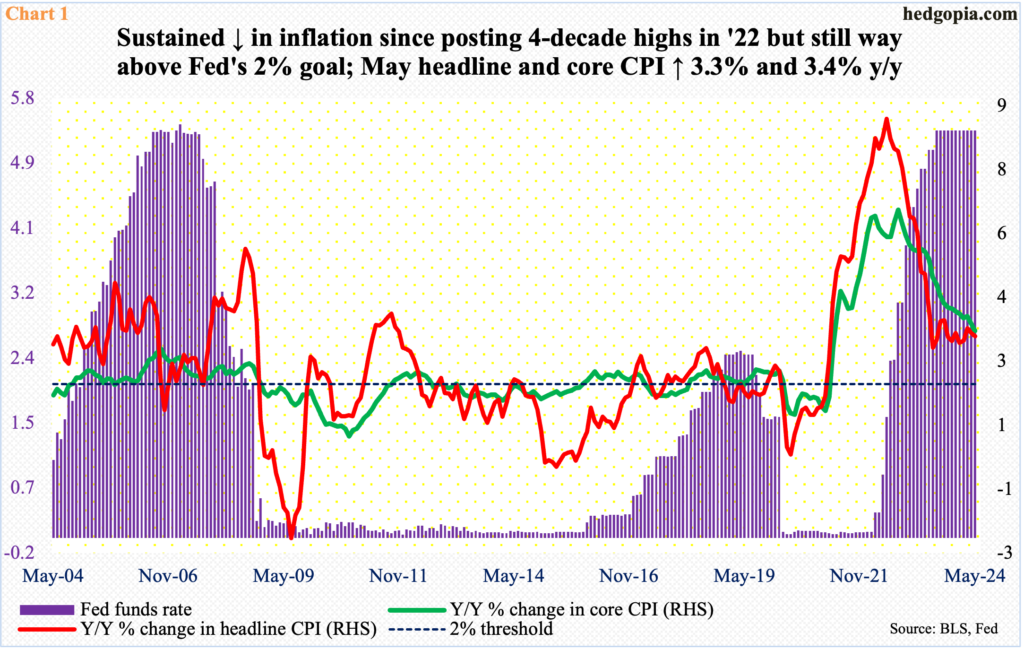
At the end of last week’s two-day FOMC meeting on Wednesday, the fed funds rate was left unchanged at a range of 525 basis points to 550 basis points. The last hike was last July, with the benchmark rates having lifted from zero to 25 basis points in March 2022.
The policy-setting body’s move last week was expected. What was probably not expected was for FOMC members to go from expecting three cuts this year during the March meeting to one; the consensus expected the dot plot to shift lower to two cuts. FOMC members’ rates outlook now is one fewer than what the futures market expects.
As much as the doves within the FOMC are itching to begin lowering rates, inflation remains comfortably above the Federal Reserve’s two-percent goal. In the 12 months to May, headline and core CPI (consumer price index) increased 3.3 percent and 3.4 percent respectively – much lower than the four-decade highs of 2022 (headline at 9.1 percent in June that year and the core at 6.6 percent in September) – but progress this year has slowed (Chart 1).
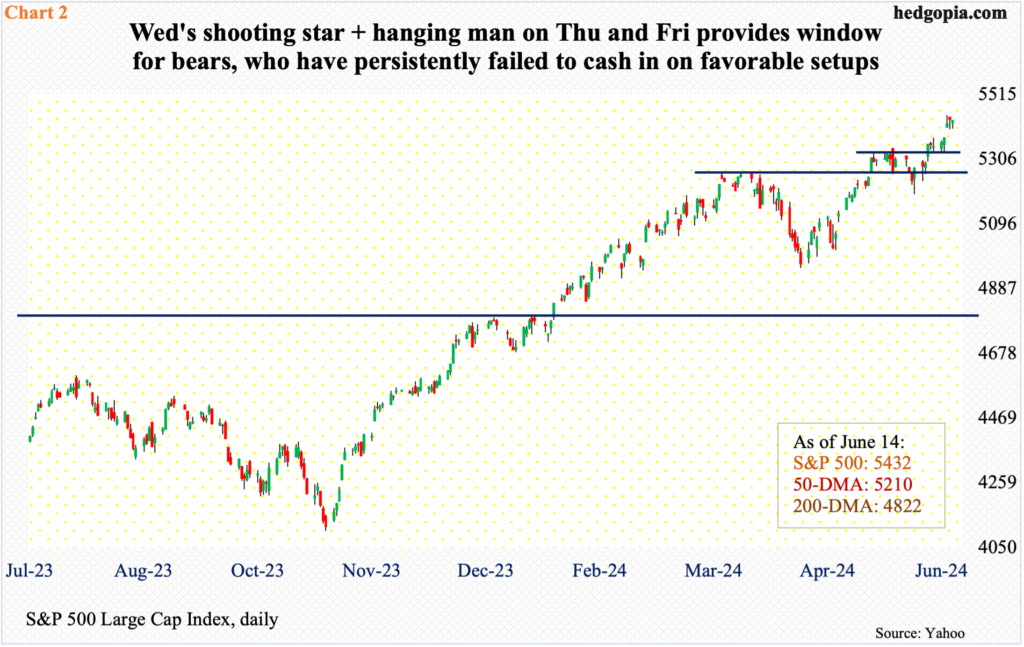
The FOMC is probably not happy with the way US equities have continued to rally, and this raises risks of upward price pressure through the wealth effect. From last October’s low through last Wednesday’s fresh intraday high of 5447, the S&P 500 is up 32.7 percent – and a mouth-watering 56 percent from the October 2022 low.
Equity bulls got aggressive last December when on the 13th Fed Chair Jerome Powell decidedly signaled a dovish shift in policy. Having just bottomed in October, the large cap index closed the 12th at 4644. Stocks were beginning to price in much lower interest rates. Post-Powell shift, futures traders early this year were pricing in six to seven 25-basis-point cuts by the end of this year.
This not surprisingly set in motion animal spirits. In more ways than one, this continues. Last week, the S&P 500 rallied 1.6 percent to 5432. This was the seventh up week in last eight. Bids persistently showed up even as it was becoming clearer that the expected cuts were not forthcoming. As things stand, two cuts are expected this year – in September and December. Stocks that rallied hard on expectation of much lower benchmark rates are not adjusting lower.
To rub salt in the wound, bears have repeatedly failed to cash in on potentially favorable technical setups. Post-October low, the S&P 500 rallied hard for four weeks before a long-legged doji – an indecision candle – showed up on the weekly. This was immediately followed by a potentially bearish hanging man, which, however, was not confirmed.
Once again, in a gap-up session in which a new high was posted, a shooting star formed last Wednesday, followed by a hanging man each on Thursday and Friday (Chart 2). This is an opportunity for the bears, but it remains to be seen if success comes their way this time.
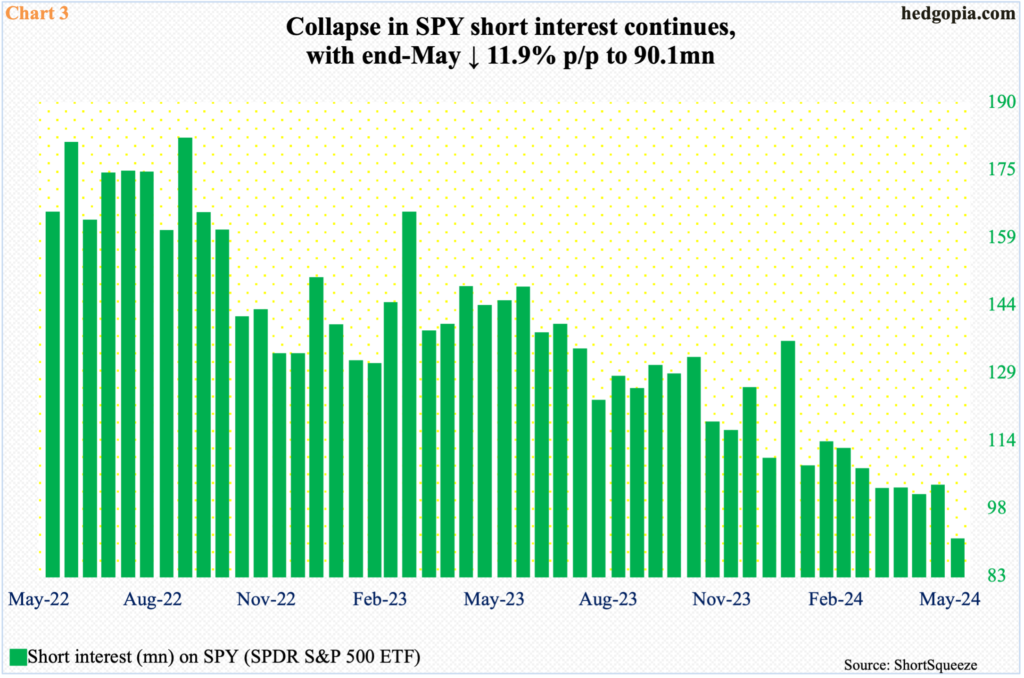
One of the things equity bulls have greatly used to their advantage is short squeeze.
As stocks were coming under severe pressure back then, by mid-September 2022, short interest on SPY (SPDR S&P 500 ETF) had ballooned to 180.5 million (Chart 3). Stocks bottomed that October, and the gradual squeeze followed. After a lot of back-and-forth, by mid-January this year, short interest once again rose to 134.7 million; it has all been downhill since then. At the end of May, short interest tumbled 11.9 percent period-over-period to 90.1 million.
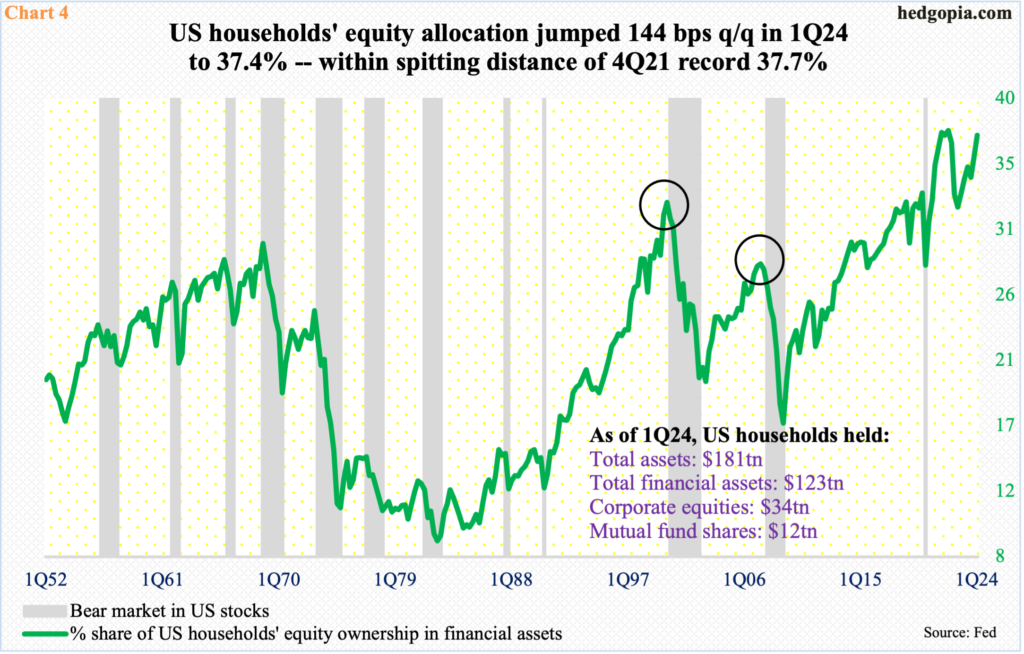
In an environment in which there is a palpable lack of fear, multiple expansion continues.
After reaching an all-time high of 37.7 percent in 4Q21, US households’ equity allocation bottomed at 32.3 percent in 3Q22. From that low, the allocation has risen to 37.4 percent by the March quarter this year (Chart 4).
With nine sessions to go in the June quarter, the S&P 500 has rallied another 3.4 percent in the current quarter. Unless the index unravels in the remaining sessions, it is all but certain the 4Q21 record will be surpassed.
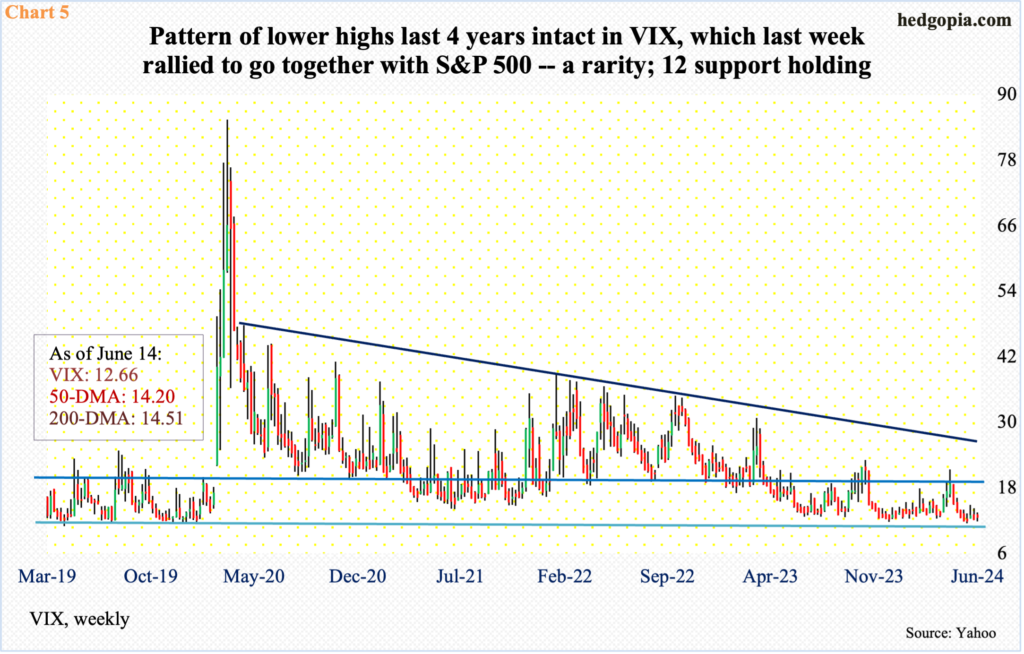
This nothing but adds to the bears’ woes. Bulls continue to treat both good and bad news as good, with bad news raising hopes for rate cuts. But at some point, this narrative will stop working, and the bears will gain the upper hand; as pointed out earlier, they have a decent opportunity here.
Amidst this, VIX’s behavior last week is worth a watch. In normal circumstances, VIX and the S&P 500 go in opposite directions. Last week, the two went hand in hand. VIX rallied 0.44 points to 12.66.
Going back six years, volatility bulls have repeatedly defended 12, and this seems to be happening again (Chart 5). VIX last Thursday dropped as low as 11.88 intraday but did not undercut the May 23rd low of 11.52.
If volatility bulls put their foot down, that will bring good news for equity bears.
More By This Author:
Unpacking The CoT Report: What Positions Are Noncommercials Taking?No Love For Small-Caps, Which Refuse To Respond To Robust Payrolls
CoT: Peek Into Future Through Futures, Hedge Funds Positions
This blog is not intended to be, nor shall it be construed as, investment advice. Neither the information nor any opinion expressed here constitutes an offer to buy or sell any security or ...
more



What Is Swing Trading?
Swing trading is a type of trading in which positions are held for a few days or weeks in order to capture short- to medium-term profits in financial securities. Swing traders use technical analysis to make trading decisions.
Most fundamentalists are swing traders since changes in corporate fundamentals generally require a short amount of time to cause sufficient price movement to render a reasonable profit. The style of swing trading lies somewhere between day trading and trend trading.
Day trading often results in very short-term holding periods of less than a single day. Profit per transaction is often the lowest.
Swing trading often results in short- to medium-hold periods. Profit per transaction is higher than day trading but lower than trend trading.
Trend trading often results in the longest hold periods. Due to low transaction volume, profits can be highest per position.
KEY TAKEAWAYS
Swing trading sits in the middle of the continuum between day trading and trend trading.
Swing traders often enter into a position, hold for days to weeks, and then exit their position having hopefully taken profits.
The first key to successful swing trading is picking the right stocks, which are often volatile and liquid.
Swing trading is contingent on market conditions, though there are different trades for every market type.
Swing trading relies heavily on technical analysis and an understanding of price channels, and uses simple moving averages.
The Right Stocks for Swing Trading
The first key to successful swing trading is picking the right stocks. There are two key variables to consider when choosing the stocks to swing trade: liquidity and volatility.
The best candidates are large-cap stocks, which are among the most actively traded stocks on the major exchanges. In an active market, these stocks will have a high transaction volume. If a stock has poor liquidity or doesn't have deep action in a broker's trade book, it may be difficult to sell or may require substantial price discounts to relinquish the shares.
In addition, volatility can be a swing trader's best friend. Without price movement, there are no opportunities to make a profit. While volatility is often thought of negatively, swing trading relies on volatility to create an opportunity to capitalize on the appreciation of a stock's price. The stocks that have the highest volatility may be the most ideal for swing trading as there are the most opportunities for profit.
The Right Market and stock signal
Financial markets typically have three prevailing long-term trends: the bear market, the bull market, or somewhere in between. A swing trading strategy is different under each environment.
Bear Market Swing Trading
Bear market swing trading is among the more difficult for natural buy-and-sell trades. In a downtrend environment, equity market prices are decreasing in the long term. Therefore, it is not advantageous to buy a security and hold it with expectations of price appreciation. There are several strategies to circumnavigate this:
Shorten your trade period. Instead of holding for weeks, be prepared to have a quicker turnaround on the securities you are holding.
Hold more cash. Plan on holding back some capital you may otherwise be trading in the event that securities you are holding do suffer material price declines.
Convert to options (by buying puts). Instead of buying now and selling later, the ideal position to hold if you believe prices are declining is to sell a security first, then buy it back later.
Bull Market Swing Trading stock signal
Alternatively, to bear markets, bull market trading may be easier. As prices tend to appreciate during these market conditions, it's easier to buy a security and experience a profit a short while later. However, there are a few things to keep in mind when swing trading during bull markets:
Entry points are higher. After liquidating your position and capturing profits, chances are greater that general market securities are now more expensive if broad markets have appreciated. Be prepared to pay higher prices for securities.
Bad habits are formed. It's often said that bad trading habits are formed during bull markets. Continue to do due diligence and market research on the best securities to hold; while it may seem like every security is a winner, this won't always be the case.
Consider leverage. Leverage trading is not for everyone, and consider your risk appetite prior to leveraging. However, if you are confident in continual appreciation of the markets, you may be able to multiply your position through leverage.
In-Between Market Conditions
The best swing trading conditions occur when financial markets are trading sideways. When the market is transitioning between bear and bull markets or when the market is facing broad uncertainty, the best positions often present themselves for swing trading. Several items to consider include: